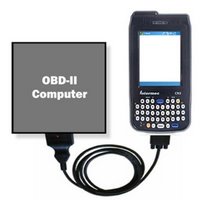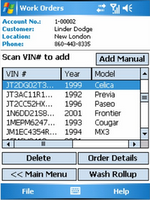
I have written a
number of times about the ability to automate business processes in mobile software applications. This screen shot demonstrates another simple example. In this screen, an estimate of the costs of detailing and repairing an automobile has been determined. The next step is the service provider's manager must approve and enter his/her initials, the technician that completed the estimate must enter his/her initials and then the auto dealer's manager must sign their name approving the services and cost. These 3 approvals complete the business process that is required in order to start the work and to get paid for the work.
This is a simple but important example. If you try to submit this work order without the proper authority, a warning message will pop-up asking for the handheld pc user to complete the business process before continueing. This is another method of helping new users remember how to appropriately complete their work. You can build guides, training help and instructions into the handheld pc application - paper forms can't do that.
It is very helpful, since much of the work completed on handheld pcs is done remotely, to have instructions, help messages and training pointers built into the mobile application.
Let's consider the following scenario - a new technician inspects a used vehicle and identifies damage to the front bumper. He correctly inputs this information into the automobile inspection software on his handheld PDA. Based on the identified damage to the front bumper, the inspection software brings up an additional set of questions:
- location of damage on the bumper
- type of damage (dent, scrape, bent, etc)
- severity of damage
- type of bumper (metal, plastic, rubber strip etc)
- Color of bumper
For each of these questions an icon is available to "click-on" for more detailed instructions on how to answer each question. This is a great training tool and helps standardize all answers to ensure the most accurate job estimates possible.
Again, this is a simple example of how a mobile software application can be designed to automate business processes and help the user know what information is required, how to answer the questions correctly and consistently without missing data or forgetting important considerations.
This application was developed using MobileDataforce's PointSync Mobility Platform.



